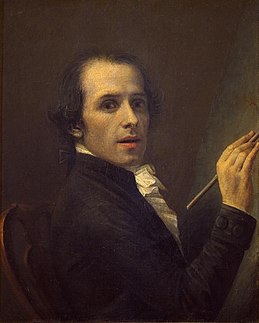
Antonio Canova was an Italian Neoclassical sculptor, famous for his marble sculptures. Often regarded as the greatest of the Neoclassical artists, his sculpture was inspired by the Baroque and the classical revival, and has been characterised as having avoided the melodramatics of the former, and the cold artificiality of the latter.
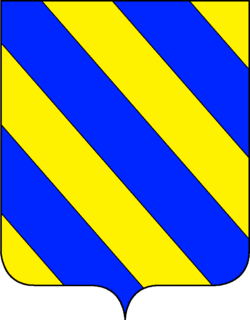
Contarini is one of the founding families of Venice and one of the oldest families of the Italian Nobility. In total eight Doges to the Republic of Venice emerged from this family, as well as 44 Procurators of San Marco, numerous ambassadors, diplomats and other notables. Among the ruling families of the republic, they held the most seats in the Great Council of Venice from the period before the Serrata del Maggior Consiglio when Councillors were elected annually to the end of the republic in 1797. The Contarini claimed to be of Roman origin through their patrilineal descendance of the Aurelii Cottae, a branch of the Roman family Aurelia, and traditionally trace their lineage back to Gaius Aurelius Cotta, consul of the Roman Republic in 252 BC and 248 BC.

Pietro Lombardo (1435–1515) was an Italian Renaissance sculptor and architect; born in Carona (Ticino), he was the father of Tullio Lombardo and Antonio Lombardo.

Antonio Lombardo (c.1458–1516) was an Italian Renaissance sculptor.

Tullio Lombardo, also known as Tullio Solari, was an Italian Renaissance sculptor. He was the brother of Antonio Lombardo and son of Pietro Lombardo. The Lombardo family worked together to sculpt famous Catholic churches and tombs. The church of Santi Giovanni e Paolo contains the Monument to Doge Pietro Mocenigo, executed with his father and brother, and the Monument to Doge Andrea Vendramin, an evocation of a Roman triumphal arch encrusted with decorative figures. Tullio also likely completed the funereal monument to Marco Cornaro in the Church of Santi Apostoli and the frieze in the Cornaro Chapel of the Santa Maria Gloriosa dei Frari. He also participated in the work to decorate Santa Maria dei Miracoli, Venice.
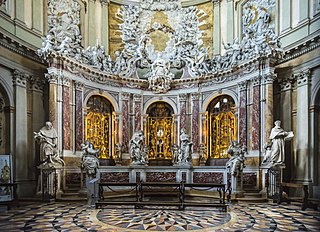
Filippo Parodi was an Italian sculptor of the Baroque period, "Genoa's first and greatest native Baroque sculptor".

The Duchy of Ferrara was a state in what is now northern Italy. It consisted of about 1,100 km2 south of the lower Po River, stretching to the valley of the lower Reno River, including the city of Ferrara. The territory that was part of the Duchy was ruled by the House of Este from 1146 to 1597.
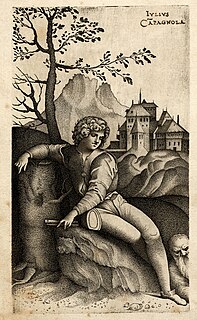
Giulio Campagnola was an Italian engraver and painter, whose few, rare, prints translated the rich Venetian Renaissance style of oil paintings of Giorgione and the early Titian into the medium of engraving; to further his exercises in gradations of tone, he also invented the stipple technique, where multitudes of tiny dots or dashes allow smooth graduations of tone in the essentially linear technique of engraving; variations on this discovery were to be of huge importance in future printmaking. He was the adoptive father of the artist Domenico Campagnola.
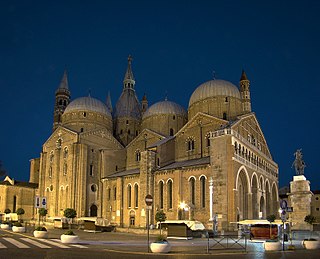
The Pontifical Basilica of Saint Anthony of Padua is a Roman Catholic church and minor basilica in Padua, Veneto, Northern Italy, dedicated to St. Anthony. Although the Basilica is visited as a place of pilgrimage by people from all over the world, it is not the titular cathedral of the city, a title belonging to the Cathedral-Basilica of St. Mary of Padua. The basilica is known locally as "il Santo". It is one of the eight international shrines recognized by the Holy See.
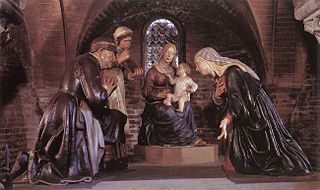
Guido Mazzoni was an Italian sculptor, mainly in terracotta, and painter of the Renaissance period, working in Bologna, Naples and France. He is also sometimes referred to as Il Modanino.
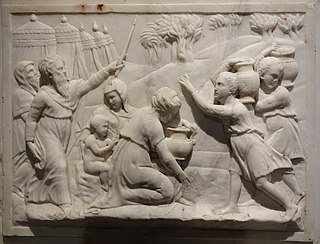
Taddeo Carlone was a Swiss-Italian sculptor and architect.

San Francesco della Vigna is a Roman Catholic church in the Sestiere of Castello in Venice, northern Italy.

Antonio Giorgetti was an Italian sculptor. He was born and died in Rome, where he spent his entire career, a disciple of Gian Lorenzo Bernini. His most prominent sculpture is the Angel with the Sponge on the Ponte Sant'Angelo, where he was working under the direction of Bernini, who provided sketches and in some instances bozzetti for the angels. For Borromini's Capella Spada in the church of San Girolamo della Carità (1660), Giorgetti provided the two kneeling angels that hold up the jasper draperies that serve as a balustrade to the altar.
Remo Rossi was a renowned Swiss sculptor, living and working in Locarno.
Mario Bernasconi was a Swiss-Italian sculptor.
The Baseggio Family included wood sculptors, painter, and an architect active mainly near Rovigo.
Antonio Soldini was a Swiss-Italian sculptor. He was born in Chiasso, near Milan.

Tiburzio Vergelli (1551-1609) was an Italian sculptor and founder.

The Sicilian Renaissance forms part of the wider currents of scholarly and artistic development known as the Renaissance in Italy and Europe as a whole. Spreading from that movement's main centres in Florence, Rome and Naples, when Renaissance Classicism reached the island of Sicily it fused with influences from local late medieval and International Gothic art and Flemish painting to form a distinctive hybrid. The 1460s is usually identified as the start of the development of this distinctive hybrid Renaissance on the island, marked by the presence of Antonello da Messina, Francesco Laurana and Domenico Gagini, all three of whom influenced each other, sometimes basing their studios in the same city at the same time.














